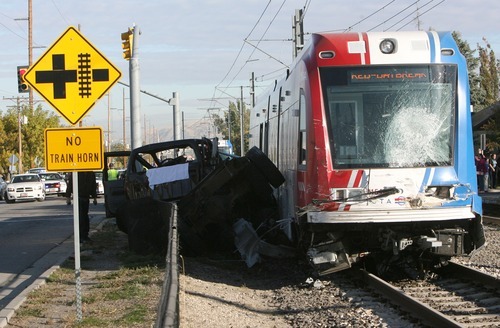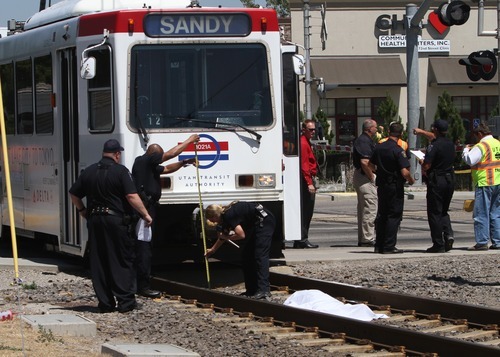This is an archived article that was published on sltrib.com in 2011, and information in the article may be outdated. It is provided only for personal research purposes and may not be reprinted.
Federal data show that TRAX trains had much higher rates of accidents, injuries and fatalities during the past five years than the transit systems nationally that are most similar to it.
And amid a rash of deadly crashes in recent months, the Utah Transit Authority acknowledged Wednesday that too many accidents are occurring — and launched a new safety campaign to decrease them.
"Safety is our No. 1 priority. Nothing else comes close," UTA General Manager Michael Allegra said at a news conference.
He said the safety campaign will include ads to urge caution around trains, creating a new chief safety officer position, conducting a systemwide review of how to improve safety and increasing enforcement of safety rules.
"It involves three E's: education, engineering and enforcement," Allegra said.
That comes after UTA had five fatalities involving TRAX trains this year, and two more involving FrontRunner commuter trains. Three of the fatalities were ruled suicides. UTA had five additional injuries on TRAX in 11 accidents, and three injuries on FrontRunner in four accidents.
The Salt Lake Tribune obtained and analyzed data about light rail accidents from the Federal Transit Agency for transit systems that it says are most similar nationally to UTA in size and service. They include agencies in Denver, Minneapolis, Sacramento, Portland and Santa Clara, Calif.
Those five agencies plus UTA averaged 14.2 "incidents," or fairly serious accidents, per 100 million passenger miles traveled between 2007 and June of this year. But UTA's rate was twice as high: 30.7.
For injuries, the six agencies together averaged 17.1 per 100 million passenger miles. UTA's rate was much higher at 27.1.
And for fatalities, Tribune analysis shows the six agencies averaged 1.18 deaths per 100 million passenger miles. But UTA averaged a higher 2.13.
A comparison for all light rail systems nationally — not just those most similar to UTA — is available for 2009. That year, light rail systems nationally averaged 7.3 deaths per 100 million passenger trips (instead of per miles traveled). UTA's rate was twice as high at 14.9.
But UTA that year had lower than average rates for injuries and incidents. The national average for all agencies for incidents was 212 per 100 million passenger trips, while UTA's average was 194.2. The national average for injuries that year was 227 per 100 million passenger trips, compared with 194.2 for UTA.
"Even one death is unacceptable to us," Allegra said — acknowledging that rates for UTA have been high recently, but said other agencies in the West have also seen increases.
"This trend seems to be evidenced by distracted activities," Allegra said. So he hopes planned ads on trains and TV will discourage wearing head phones or texting around tracks, discourage straying beyond yellow lines at stations, and encourage looking both ways at crossings.
UTA spokesman Gerry Carpenter said that although UTA has a worse safety record than agencies most similar to it, he said the systems are still much different — and comparing them is a bit like comparing apples and oranges.
UTA tends to have more at-grade street crossings than the other agencies, for example, which may lead to more accidents, said Carpenter.
He added that most accidents involving TRAX occur in downtown Salt Lake City where trains share streets with cars, rather than in areas where it has a separate right of way.
Phoenix started a system somewhat similar to TRAX a couple years ago, Carpenter said, and its accident rate has been far higher than UTA's because it runs in areas where residents were not used to trains. He noted TRAX had high rates when its system started, but the accident rate decreased over time.
Also of note, in looking at data since 2002, FTA data shows that UTA's safety record during the period is virtually identical to the five other similar systems. Only in recent years are rates higher for UTA.
Carpenter said UTA officials think the recent rash of accidents may be a result of the newly opened West Valley City and Mid-Jordan TRAX extensions putting trains in areas where people were not used to them, and the increased the frequency of trains along central lines has surprised some people.
Allegra said a new chief safety officer position will lead a review of the entire system looking for ways to bolster safety.
As an example, he said the agency may turn up the volume on TRAX train gongs. It had been lowered recently because of complaints by neighbors about noise, but some riders complained they can not hear trains approaching stations.







